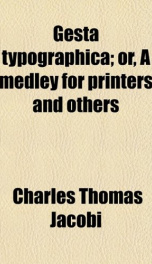gesta typographica or a medley for printers and others

Purchase of this book includes free trial access to www.million-books.com where you can read more than a million books for free. This is an OCR edition with typos. Excerpt from book: ERRATA [CUM GRANO SALIS] " Ob, let him alone For making a blunder or picking a bone." ERRATA Origin of Errata. In works of the remotest dates, tables of errata are seldom, perhaps never found; but the faults of the impreftion were corrected with the pen previously to the dispersion of the work. This is exemplified in the earliest editions of Gering, Caxton, and several others. A similar mode of correction appears to have been adopted, so late as the year 1534, by the editor of the "Discourses of Clictou." But the labour of manual correction was of short duration. Through the ignorance of sordid printers, errors of the preft soon became very numerous, and to correct them with the pen was but in other words to disfigure the volume throughout, and make a disgusting display of its imperfections. The custom was consequently adopted of affixing the most important corrections, under the title of errata, at the end of the volume. The compositor who set up .10,000 to read one thousand, might have prevented his mistake by a little fourth-ought. Gesta Typo- Besides the ordinary errata, which happen graphica in printing a work, others have been purposely committed that the errata may contain what is not permitted to appear in the body of the work. Wherever the Inquisition had any power, particularly at Rome, it was not allowed to employ the word fatum, or fata, in any book. An author, desirous of using the latter word, adroitly invented this scheme: he had printed in his book fafia, and, in the errata, he put, " for 'fafia ' read lfata.'" The Baron de Grimm, in his " Memoirs," mentions the extraordinary circumstance of an irritable French author having died in a fit of anger, in consequence of a favourite work, which he had himself revised with great care, having...
Info about the book
Author:
Series:
Unknown
ASIN:
B008KO7VSC
Rating:
3.5/5 (5)Your rating:
0/5
Languge:
English
Users who have this book
Users who want this book
What readers are saying
What do you think? Write your own comment on this book!
write a commentGenre
if you like gesta typographica or a medley for printers and others try:
Do you want to read a book that interests you? It’s EASY!
Create an account and send a request for reading to other users on the Webpage of the book!




